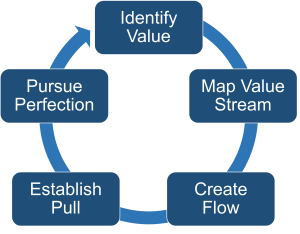13.5 Lean Implications
Implementing lean within any organization, whether in manufacturing or the service sector, requires a disciplined and structured approach to ensure both effective transition and sustainable improvements. A recognized methodology for deploying lean principles involves a series of interconnected steps that together form a comprehensive roadmap for organizations aspiring to embrace lean practices. This section elucidates these steps, with an emphasis on Value Stream Mapping (VSM), and provides examples from manufacturing and service contexts, illustrating the application of these principles.
13.5.1 The Five Steps of Lean Implementation

- Identifying Value is the foundational step in lean implementation, necessitating a deep understanding of what constitutes value from the customer’s perspective. It involves discerning which activities add value—as deemed by the customer—and which do not. This discernment is crucial for focusing efforts on what truly matters to the customer, ensuring that the organization’s outputs align with customer expectations and willingness to pay.
- Mapping the Value Stream is the process of visually depicting all the actions required to bring a product or service from concept to delivery to the customer. Through Value Stream Mapping, organizations chart both the flow of materials and the information that drives the process, identifying and highlighting waste in its various forms—be it overproduction, waiting, unnecessary transport, overprocessing, excess inventory, unnecessary movements, or defects. This comprehensive mapping serves not only to diagnose inefficiencies but also to envision an optimized future state where value flows smoothly to the customer.
- Once waste is identified and a future state is envisioned, the next phase, Creating Flow, focuses on ensuring that the steps in delivering value to the customer proceed smoothly and without interruption. This may involve reorganizing work sequences, enhancing cross-functional collaboration, or adopting new technologies to ensure a seamless flow of value.
- In the Establish Pull phase, the shift is towards producing only what is needed when it is needed, based on actual customer demand, rather than on forecasts. This pull-based approach helps in minimizing waste associated with overproduction and excess inventory, aligning production or service delivery more closely with real-time demand.
- The journey of lean transformation is ongoing, as highlighted in the phase of Pursuing Perfection. This perpetual cycle of evaluation and improvement encourages organizations to continuously seek ways to eliminate waste, improve processes, and enhance value delivered to customers. It fosters an organizational culture dedicated to excellence and constant evolution.
It’s pivotal to understand that these five steps of lean implementation are not linear but rather operate in a continuous loop. There is no definitive endpoint in the journey toward lean; each cycle of improvement opens new avenues for further enhancements, embedding a culture of continuous improvement within the organization. This iterative process ensures that lean principles become deeply ingrained in the organizational fabric, driving long-term sustainability and adaptability.
13.5.2 Examples of Lean Implementation
In the manufacturing realm, consider a company that embarks on this lean journey by first identifying what their customers truly value in their products. Through value stream mapping, they uncover inefficiencies in their production line that lead to delays and overproduction. By reorganizing their production processes to create a smoother flow and adopting a pull system that aligns production with actual customer orders, they significantly reduce waste and improve delivery times. Pursuing perfection becomes an ongoing endeavor, with the organization continually seeking ways to refine and improve its processes.
Similarly, in the service sector, a hospital may apply these lean steps to enhance patient care. By understanding patient value as timely and effective treatment, the hospital uses value stream mapping to identify bottlenecks in patient flow. Implementing changes to ensure a smoother flow of patients through the facility, and establishing pull mechanisms that align resources with patient needs, the hospital improves both efficiency and patient satisfaction. The pursuit of perfection is relentless, with ongoing efforts to refine processes and eliminate waste.
13.5.3 Culture Change: The Essence of Lean
Crucially, lean implementation transcends the mere adoption of tools and techniques; it signifies a profound shift in organizational culture. This cultural transformation, underpinned by a commitment to continuous improvement and waste elimination, is the cornerstone of lean. It requires engagement and alignment at all levels of the organization, fostering an environment where every employee is empowered to contribute to the lean journey. This paradigm shift ensures that lean principles are not only implemented but are sustained and evolved over time, securing long-term success and adaptability in a changing market landscape.
Through these steps and the ongoing cycle of improvement, lean offers a powerful framework for organizations to enhance efficiency, reduce waste, and most importantly, deliver greater value to customers.
